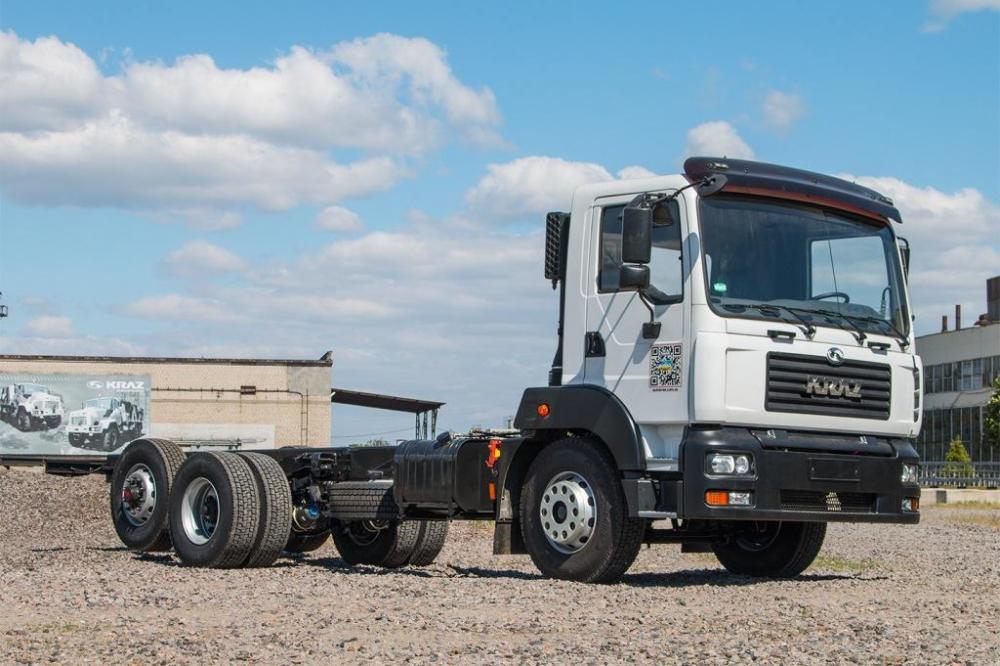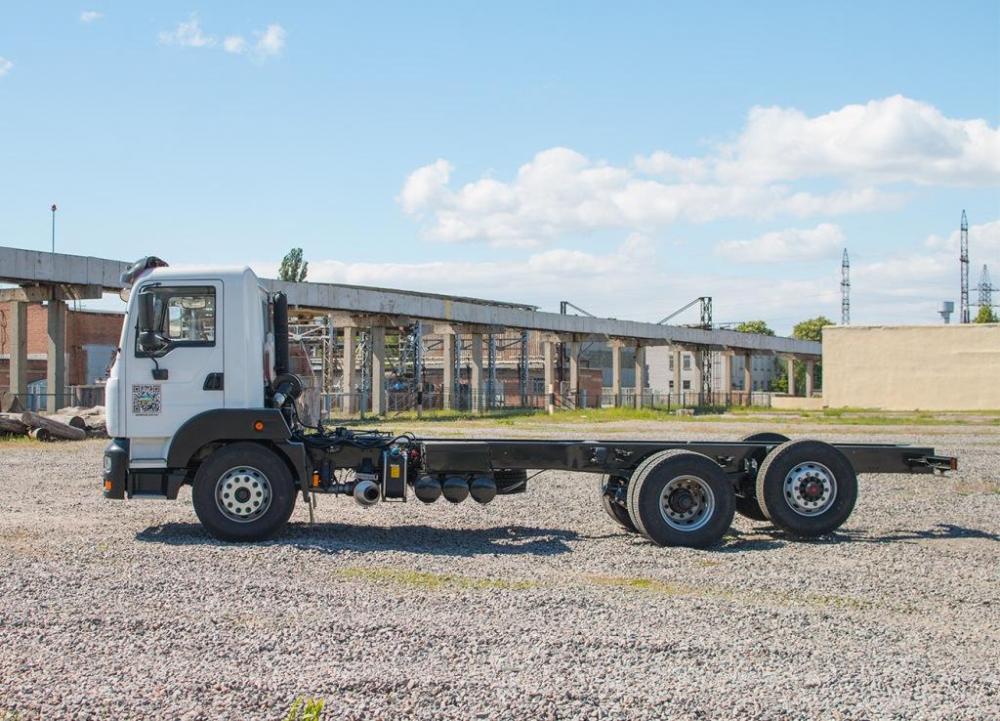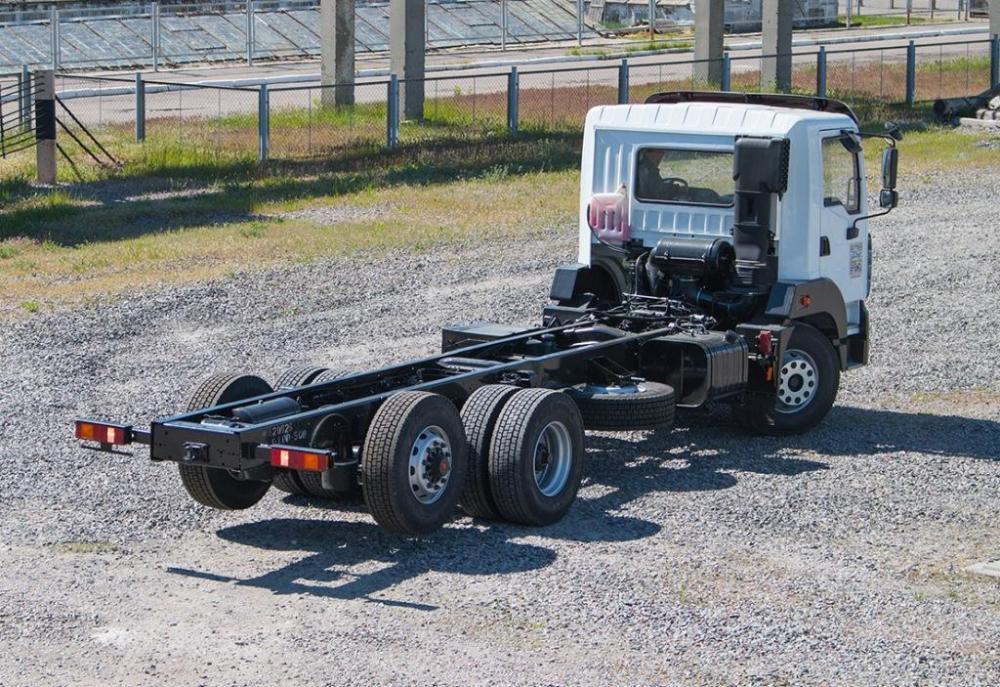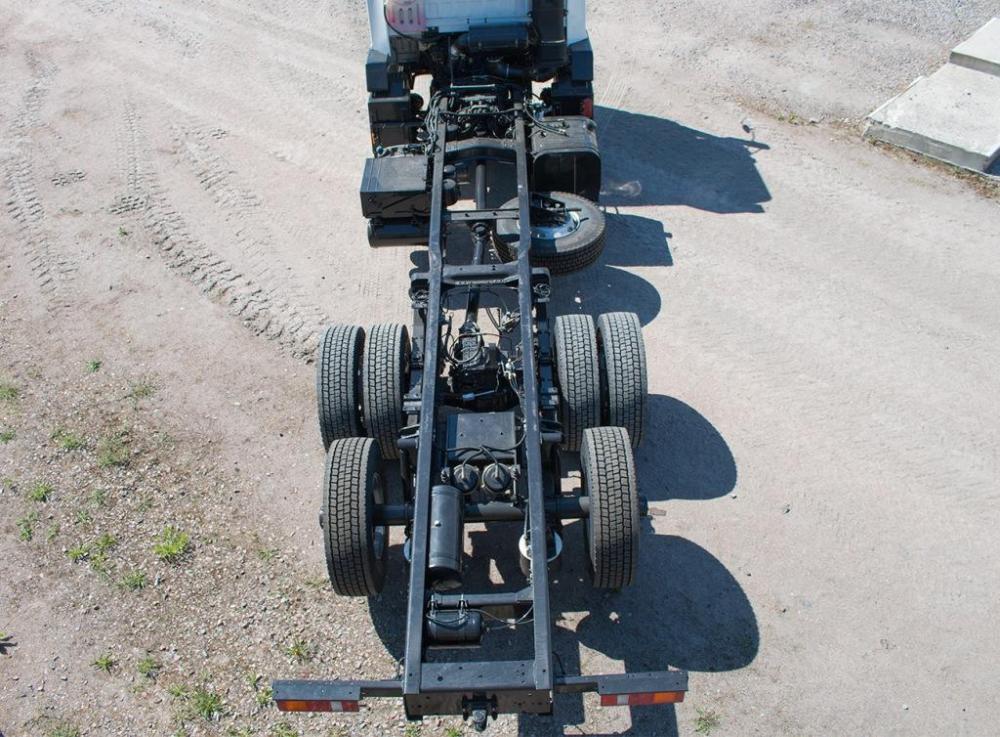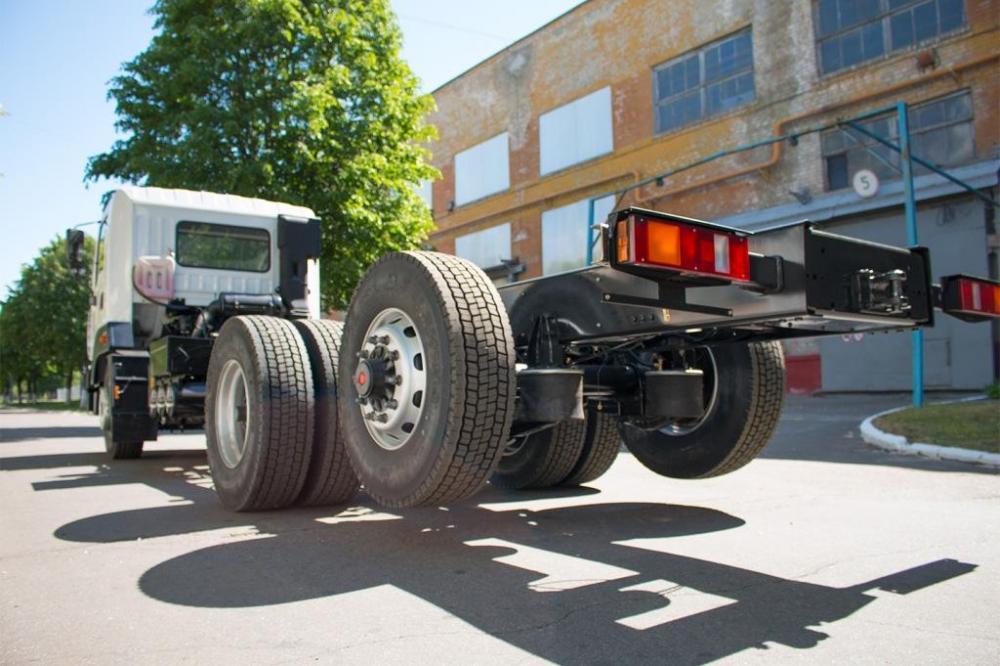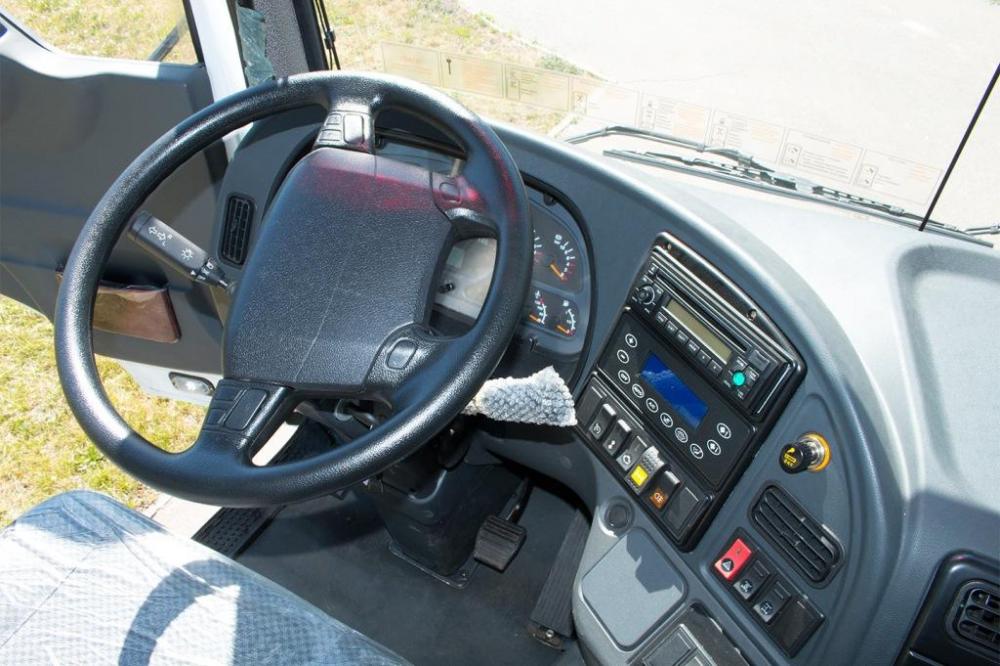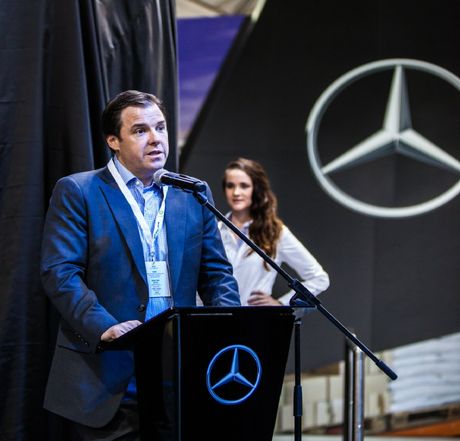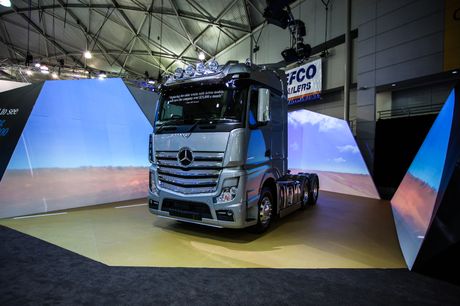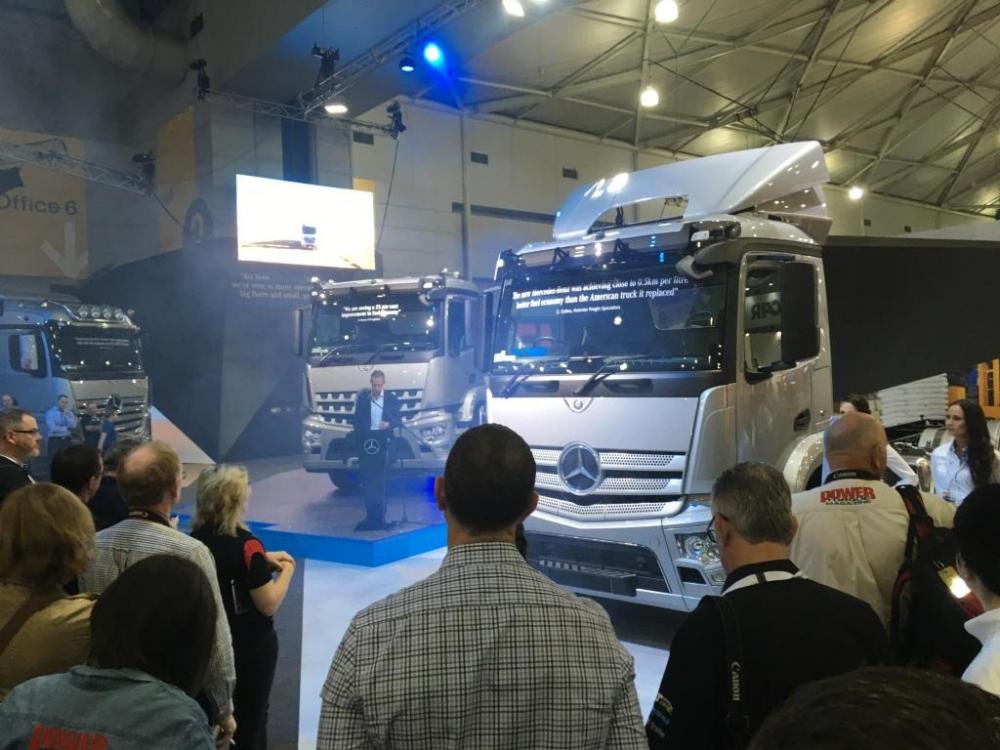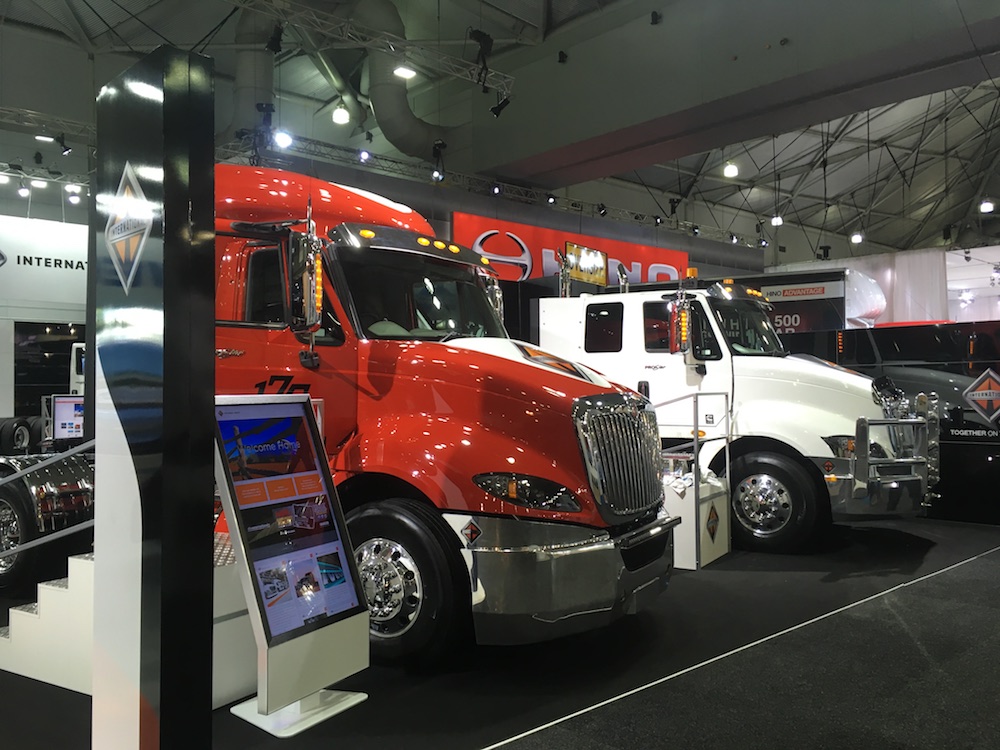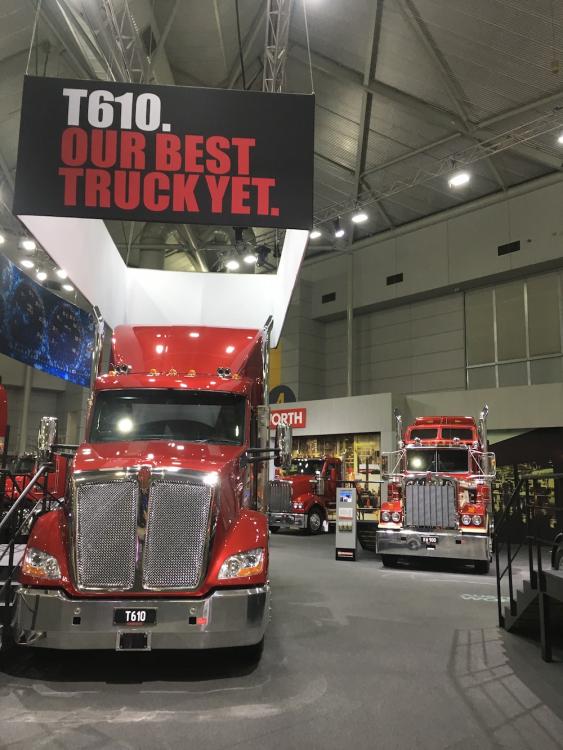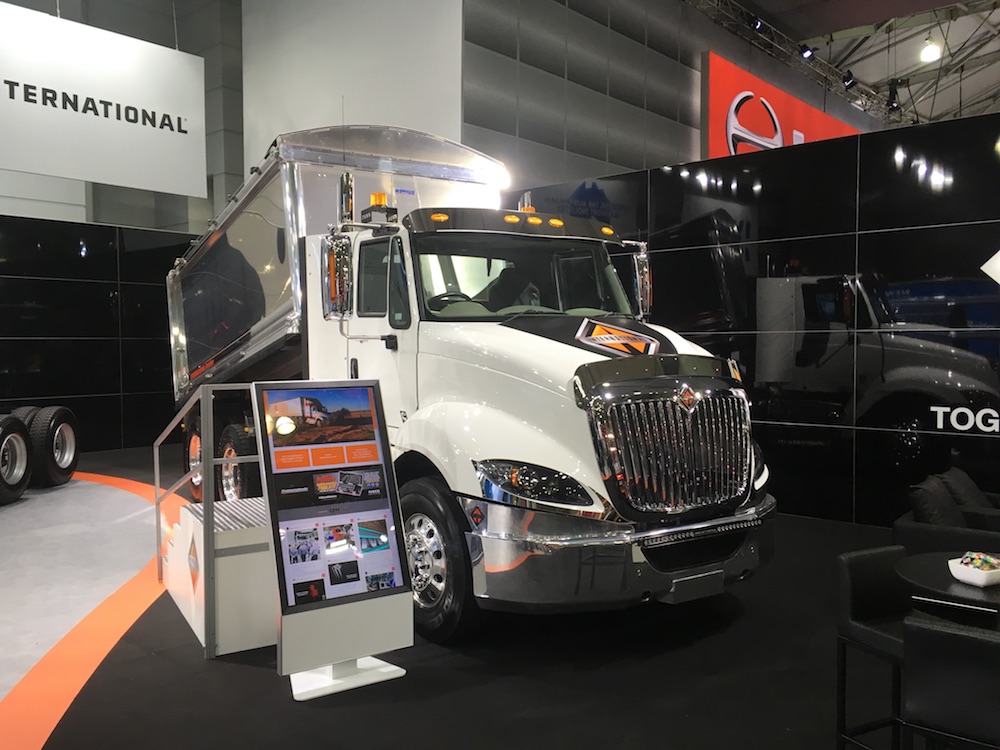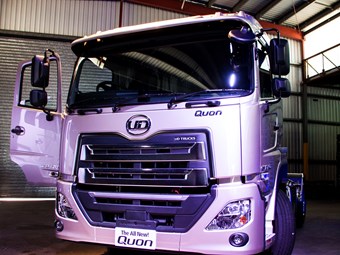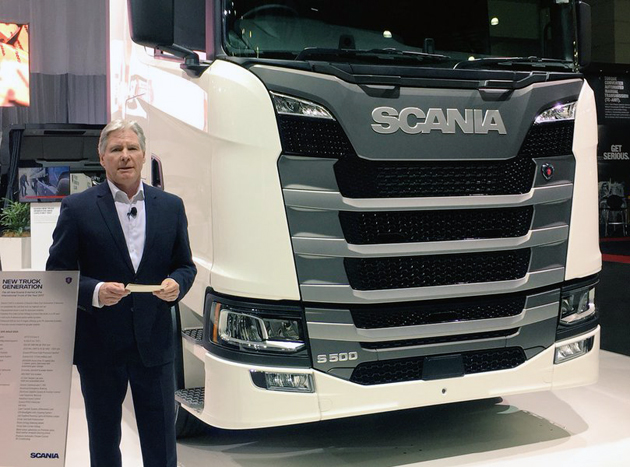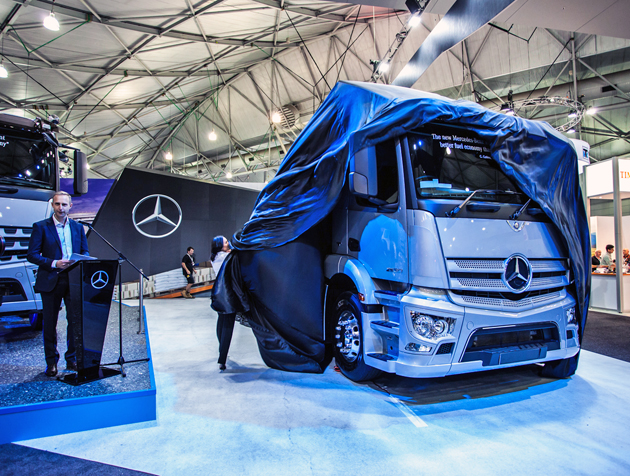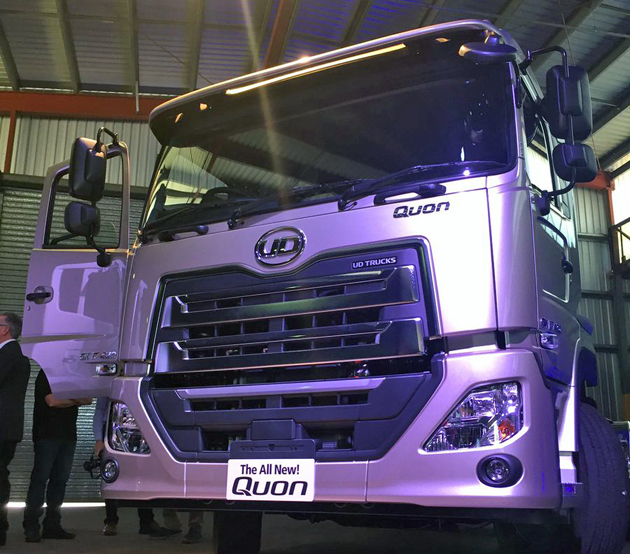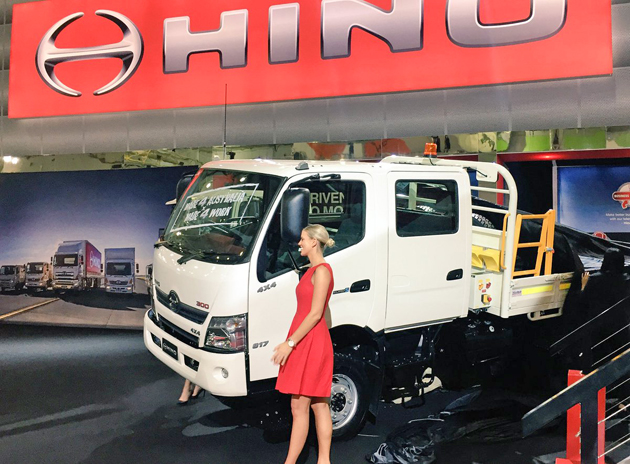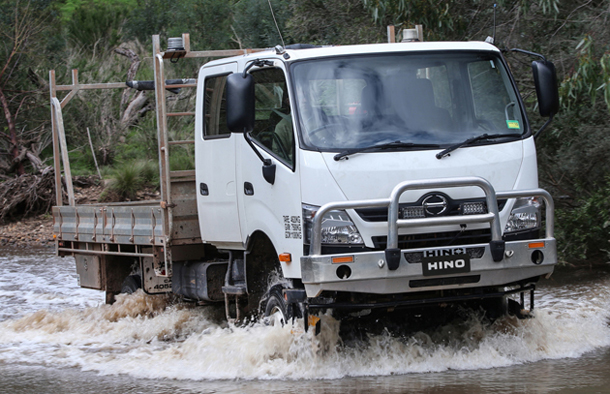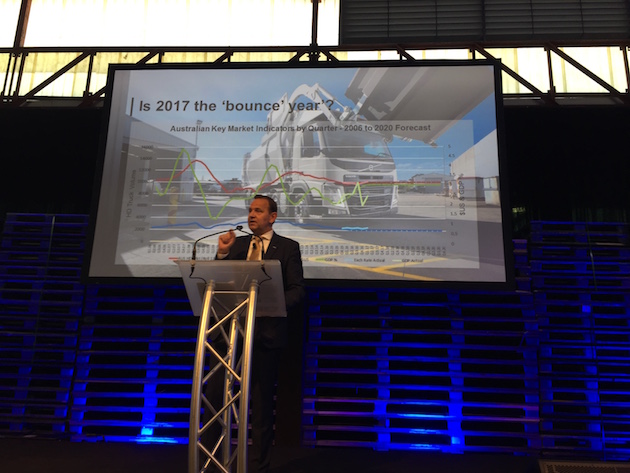
kscarbel2
Moderator-
Posts
18,908 -
Joined
-
Days Won
114
Content Type
Profiles
Forums
Gallery
Events
Blogs
BMT Wiki
Collections
Store
Everything posted by kscarbel2
-
New Mack for the fall
kscarbel2 replied to james j neiweem's topic in Modern Mack Truck General Discussion
For some time now, all the Mack dealers have had in their possession a teaser video showing the new Mack model. They cut off the roof to make it stand up, more competitive for long haul. You can ask your local salesman to show it to you. It looks as if the same stylist responsible for the US market CAT vocational trucks was hired by Volvo to create the styling cues for the new model. -
Sisu partners to develop hybrid heavy truck powertrain
kscarbel2 replied to kscarbel2's topic in Trucking News
. . -
I’m repeatedly on record as despising the post-Ted Turner CNN. But that said, this news report actually makes sense. ------------------------------------------------------------------------------ CNN / May 26, 2017 Then-FBI Director James Comey knew that a critical piece of information relating to the investigation into Hillary Clinton's email was fake -- created by Russian intelligence -- but he feared that if it became public it would undermine the probe and the Justice Department itself, according to multiple officials with knowledge of the process. As a result, Comey acted unilaterally last summer to publicly declare the investigation over -- without consulting then-Attorney General Loretta Lynch -- while at the same time stating that Clinton had been "extremely careless" in her handling of classified information. His press conference caused a firestorm of controversy and drew criticism from both Democrats and Republicans. Comey's actions based on what he knew was Russian disinformation offer a stark example of the way Russian interference impacted the decisions of the highest-level US officials during the 2016 campaign. The Washington Post reported Wednesday that this Russian intelligence was unreliable. US officials now say Comey and FBI officials actually knew early on that this intelligence was indeed false. In fact, acting FBI Director Andrew McCabe went to Capitol Hill Thursday to push back on the notion that the FBI was duped, according to a source familiar with a meeting McCabe had with members of the Senate intelligence committee. The Russian intelligence at issue purported to show that then-Attorney General Lynch had been compromised in the Clinton investigation. The intelligence described emails between then-Democratic National Committee Chair Debbie Wasserman Schultz and a political operative suggesting that Lynch would make the FBI investigation of Clinton go away. In classified sessions with members of Congress several months ago, Comey described those emails in the Russian claim and expressed his concern that this Russian information could "drop" and that would undermine the Clinton investigation and the Justice Department in general, according to one government official. Still, Comey did not let on to lawmakers that there were doubts about the veracity of the intelligence, according to sources familiar with the briefings. It is unclear why Comey was not more forthcoming in a classified setting. Sources close to Comey say he felt that it didn't matter if the information was accurate, because his big fear was that if the Russians released the information publicly, there would be no way for law enforcement and intelligence officials to discredit it without burning intelligence sources and methods. There were other factors behind Comey's decision, sources say. In at least one classified session, Comey cited that intelligence as the primary reason he took the unusual step of publicly announcing the end of the Clinton email probe. In that briefing, Comey did not even mention the other reason he gave in public testimony for acting independently of the Justice Department -- that Lynch was compromised because Bill Clinton boarded her plane and spoke to her during the investigation, these sources say.
-
By Sir Roger Moore For The Daily Mail The first rule when I took over as James Bond was: no Martinis, either shaken or stirred. Producer Cubby Broccoli had just handed me a contract to play 007 and I was ecstatic about it. It was 1972, I was 44 years old and although I had enjoyed huge TV success with The Saint, I was not a cinema star. This role had been a long time coming. Although I hadn’t known it at the time, I had apparently been on the shortlist for Bond a decade earlier for the first film, Dr No. The part went to some Scottish guy called Sean. Then, when Sean was getting fed up in the mid-Sixties, my name came up again. This time, an Australian underwear model called George [Lazenby] got the nod. So when Bond was up for grabs once more, I was determined not to rock the boat. Director Guy Hamilton banned that trademark Martini line because he was anxious that I shouldn’t have any lines that were associated with Sean. ‘Of course,’ I said smoothly. A little later my phone rang, with a message for me from Broccoli’s co-producer, Harry Saltzman: ‘Cubby thinks you need to lose a little weight.’ Well, I’d been filming the TV series The Persuaders with Tony Curtis, whose love of the good life had rubbed off on me. ‘OK,’ I said, and started a strict diet. The phone rang again: ‘Cubby thinks you’re a little out of shape.’ So I started a tough fitness regimen. Again the phone rang, and this time it was Cubby: ‘Harry thinks your hair is a little too long.’ ‘Why didn’t you just cast a thin, fit, bald fellow in the first place and avoid putting me through this hell?’ I replied. Filming on Live And Let Die began that October in New York before moving to New Orleans, where I was to suffer my first — but by no means last — injury as Bond, in the big jet-boat chase. The thing about jet boats is, although they are lovely to drive, to turn them you have to pile on the speed. I did quite a few run-throughs to practise my technique and while banking on one such run, I realised that there wasn’t much fuel left in the tank — as the engine cut out. I had no steering! I therefore continued in a straight line... directly into a wooden boathouse. On impact, I flew out of the boat and into a wall, cracking my front teeth and twisting my knee badly. I needed a walking cane for days afterwards, but fortunately most of the schedule involved me sitting down in the boat. There I was, a fearless 007, hobbling on a cane to my boat and then pretending to be indestructible for the cameras. Who says I can’t act? Our last sequence in New Orleans was the airfield one, where Bond gives an unorthodox flying lesson to Mrs Bell. On my last scene, I suddenly felt a terrible pain in my groin. I asked to be excused and went to lie down in my trailer for a while. A short time later, assistant director Derek Cracknell came calling, took one look at his heroic star with knees under his chin — I was in such pain — and sent me to hospital, where they decided it was a kidney stone problem. All sorts of painkilling drugs were administered. I was doped to the eyeballs when an officious little chap walked in with a clipboard. ‘Name?’ he asked. ‘Roger Moore,’ I moaned. ‘Who do you work for?’ ‘Eon Productions,’ I said. ‘What’s their address?’ ‘I don’t know,’ I said, wondering what the hell this had to do with my recovery. ‘You don’t know who you work for?’ he snapped incredulously. ‘Where do you live?’ ‘Sherwood House, Tilehouse Lane, Denham,’ I replied. ‘What number?’ ‘I don’t have a number, my house has a name.’ He was really beginning to annoy me, delirious or not. ‘OK, then,’ he added smartly, ‘how does the mailman find you without a number?’ ‘Because I’m f***ing famous!’ I shouted, in the hope of silencing him once and for all. ‘Oh. Oh!’ he said sheepishly, sliding sideways out of my room, never to be seen again. That evening they discharged me and I went back to my hotel with my various painkillers and other medications. One in particular — a methylene-based drug — had the side-effect of turning my urine bright blue, you’ll no doubt be thrilled to hear. Well, I really was quite zonked out and in unfamiliar surroundings, so when I got up for a pee at two in the morning, I opened what I thought was the bathroom door and relieved myself. I later discovered it had, in fact, been the wardrobe door I’d opened, as all my lovely clothes had turned various shades of patchy blue. Back at Pinewood Studios we completed work on the many interior sets, including that of James Bond’s flat, where I spent a very happy morning in bed with the exquisite Madeline Smith, who played Italian agent Miss Caruso. This scene featured my favourite Bond gadget of all, the magnetic watch, which I used to unzip Maddy’s dress. I must admit that not all the gadgets in Bond films actually work. To achieve the impression that this one did, special-effects supremo Derek Meddings fixed a metal wire inside Maddy’s dress and to the back of her zip. He then placed his hand up her dress and gently pulled as I ran my watch down her back saying ‘sheer magnetism’. I believe Maddy dispensed with the services of special effects men in subsequent romantic interludes. The film was to premiere on July 6, 1973. It was when I was on the way to the premiere press conference that I felt my first nerves. It finally dawned on me that my first James Bond adventure was going to be put to the ultimate test: the viewing public. But I was fairly philosophical. I imagine it’s like having a baby — there’s nothing you can do to stop it, the baby is going to come out no matter what. ‘Ah, well,’ I thought. ‘I can always go back to modelling sweaters.’ The film, which was budgeted at $7 million, took $126 million (£98 million) at the worldwide box office. Not a bad return, is it? I think everyone was pleased. Keen to capitalise on our success, Cubby and Harry fast-tracked the next Bond film, The Man With The Golden Gun, into pre-production. Filming started in Hong Kong in the summer of 1974, and that’s when I met my two lovely Swedish leading ladies, Maud Adams and Britt Ekland. We stayed at the Peninsula Hotel in Hong Kong. It was there that I first met Hervé Villechaize, the inimitable 3ft 11in villain Nick Nack. Hervé loved the ladies and would often go to the city’s strip clubs, picking out the girls he wanted with a torch: ‘You, you and you... no, not you... yes, you,’ before taking them back to his hotel room. One night he tried it on with Maud, who played the villainous Scaramanga’s mistress. Hervé walked over to her in the hotel lobby, his head only reaching the bottom of her skirt, and announced: ‘Tonight, Maud, I am going to enter your room, climb under your sheets and make wild, passionate love to you.’ ‘Yes,’ said Maud, without missing a beat, ‘and if I find out that you have, I’ll be very angry.’ After Hong Kong the film moved location to Bangkok, where we filmed another boat chase, this time on the khlongs, the waterways threading around the city. The word went round that, if we fell in, under no circumstances should we let any of the filthy water pass our lips. I did fall in though — twice, in fact. The first time was deliberate but the second time I took a bend on the river — near an undertaker’s — just a bit too tight and lost my balance. I stayed under to avoid the propeller but made the mistake of opening my eyes — and discovered what the undertaker did with some of the poorer people’s bodies. When I look back on the sequence now, I cringe when I think of pushing the little boy who climbed into Bond’s boat trying to sell a wooden elephant, into the khlong. The final scene I filmed, by the way, appeared early on in the movie, where I meet a belly dancer in an attempt to retrieve a golden bullet. I was wearing a rather nice silk suit and looking forward to snaffling it for myself at the end of the day. As we filmed, I couldn’t understand why our producer, Cubby, had dragged a stepladder on stage. He was perched at the top, looking down on us, just out of shot. But when the director shouted, ‘That’s a wrap!’ I found out. A huge bucket of paste came down on top of me and all over my lovely new suit. Cubby looked down at what he’d achieved, howling with laughter. On every Bond film I was in we made a tape of the funniest moments and the next Bond film I made, The Spy Who Loved Me, was no exception. One moment, however, was not so funny for me at the time. It was my final scene with our wonderful villain Curt Jurgens. Sitting at his dining table, he beckoned Bond to sit at the other end while reaching for his gun, which was attached to the underside. I was supposed to stand behind a chair which, in turn, was to blow up when he fired. ‘Wouldn’t it add more suspense if I sat in the chair?’ I suggested to the director, Lewis Gilbert. ‘Yes, dear, that sounds like an idea,’ he said. So I did. Unfortunately for me, our special-effects man was a bit too quick on the button and my backside was only an inch off the chair when he blew it up. My rear end caught fire and it was pretty painful, as was my language. I had to change the dressing twice a day for weeks. It was in The Spy Who Loved Me that Jaws made his first appearance. On location in Egypt, at the Temple of Karnak, there was a wonderful fight scene between Bond and the 7ft 2in giant of a henchman, resplendent with steel teeth and played by Richard Kiel. Despite being so tall, Richard was terrified of heights. When Lewis told him he would have to cross some scaffolding high above the Temples, he went pale. ‘I don’t even like being this tall,’ he said. In Cairo I had another fight scene on the roof of a museum. Milton Reid was cast as the henchman who takes on 007. On the day of the fight, our stunt arranger Bob Simmons explained to Milton that he had to fall off the roof, with me snapping him away after he held on to my tie to prevent his fall. ‘You’re going to have to fall off this roof, Milton,’ Bob said. Milton — a burly and rather menacing-looking chap — took a peek over the edge. ‘Oh! But it’s six storeys, Bob! I can’t do that.’ ‘No, we’ll pile up boxes to the fourth storey, Milton. You just fall two,’ added Bob, now determined to wind him up. ‘Can’t I fall just one storey?’ ‘No, no, we need a long scream.’ ‘Well,’ reasoned Milton. ‘Can’t I do a short fall and long scream?’ Poor Milton, they did wind him up so much. With villains defeated, Bond getting his girl and the adventure over, we called a wrap. The film was certainly lighter than my previous two Bond efforts but it suited my style and persona.It was certainly my favourite of the Bonds I made. My contention about my ‘light’ portrayal of Bond is this: how can he be a spy, yet walk into any bar in the world and have the bartender recognise him and serve him his favourite drink? Come on, it’s all a big joke. Jaws returned in Moonraker. Some scenes were shot in Venice, but before the authorities would allow us to stage gunfights on the canals and drive a speedboat-cum-hovercraft across St Mark’s Square (those startled tourists are real, by the way, not extras), I had to agree to attend a ‘Save Venice’ charity function at a huge house just off the Grand Canal. Ken Adam, the production designer, offered to come with me. We eventually found the bar and soon realised we were the youngest people there. We had just taken a sip of our drinks when a white-haired old lady, in a very strangulated upper-class English country voice, asked: ‘What are you doing here in Venice?’ ‘We’re making a film,’ I said. ‘Oh, a fillum, eh? What sort of fillum?’ ‘It’s James Bond, 007.’ ‘Ohhh! And what do you do?’ she asked. Ken was now snorting with laughter behind her back. I could have killed him. ‘Well, I sort of try to play James Bond,’ was my considered reply. She paused, moved back, looked me up and down, then announced: ‘You’ll be very good. I know Ian Fleming, you know.’ I wonder if she realised he’d been dead 15 years? I was plagued again by kidney stones during the making of Moonraker. It was tough on my co-star Lois Chiles, who played Dr Holly Goodhead and had her schedule badly messed about by my frequence absences for hospital treatment. Finally, after I’d treated myself with painkillers, booze and muscle relaxants, then gone to a party (none of which was a good idea), my kidney stone worked its way out. Our publicist issued an outrageous press statement: ‘The good news is that Roger Moore has passed his kidney stone. The bad news is that Lois Chiles has swallowed it.’ My last Bond film was A View To A Kill, in which my co-star was the eccentric singer Grace Jones. I liked her boyfriend Dolph Lundgren, but I’m afraid my diplomatic charm was stretched to the limit by Miss Jones. Every day in her dressing room she played very loud rock music that made the walls shake. An afternoon nap was out of the question. I did ask her several times to turn it down, to no avail. One day I snapped. I marched into her room, yanked the plug out, then flung a chair at the wall. The dent is still there. Still, we had yet to do a love scene together. I slipped between the sheets. She slid in beside me, bringing with her an enormous black sex toy. Very funny. I daresay I should have used a stunt double, but who would have volunteered? The truth is that, of all the ladies in my seven Bond films, the only one I think of with regret is the wonderful Lois Maxwell — and that’s because she never received the promotion she deserved. Lois and I had worked on The Saint and The Persuaders, but the public always thought of her as Miss Moneypenny, the unflappable MI6 secretary. After Bernard Lee, who played secret service chief ‘M’, died in 1981, Lois suggested to Cubby that she was his natural heir. Moneypenny would simply become ‘M’. Cubby gave her a patronising smile and assured her a woman could never run MI6. Apparently Dame Judi Dench, who was ‘M’ to my successors Pierce Brosnan and Daniel Craig, didn’t get that memo. What a shame for Lois... the ultimate Bond Girl. ---------------------------------------------------------------------------- The name's... Paul McCartney Music plays a huge part in the Bond legend — from the opening ‘gun-barrel’ sequence’, featuring Monty Norman’s classic theme, to the instantly recognisable incidental music and the chart-busting songs. One of the biggest was Paul McCartney’s Live And Let Die, which nearly didn’t happen... because producer Harry Saltzman apparently had no idea who the Beatles were. It was Joan Collins’s then husband, Ron Kass, who first suggested it. He was a music business lawyer who had represented the Fab Four’s record label, Apple. At his urging, Paul agreed to write and perform the theme song, which turned out to be an absolute belter. When he heard it, though, Harry wasn’t too sure. He turned to music producer George Martin and said: ‘So, who are we gonna get to sing it?’ George pointed out, as politely as he could, that they already had Macca and they weren’t going to find anyone bigger.
-
Starting from Dry
kscarbel2 replied to LFD1935's topic in Antique and Classic Mack Trucks General Discussion
Billy, Wisconsin engines have been rare birds in my life. I saw more Clinton engines on Yazoo push mowers. -
Trump blasts German automakers' U.S. sales and threatens barriers Bloomberg / May 26, 2017 BERLIN -- German carmakers found themselves at the receiving end of renewed attacks by President Donald Trump, who reportedly chided them for selling too many vehicles in the U.S., contributing to a lopsided German trade surplus that's hurting the U.S. economy. "The Germans are bad, very bad," Trump told EU officials in a closed-door meeting, Der Spiegel reported. "Look at the millions of cars that they sell in the U.S. Terrible. We're going to stop that." Trump's top economic adviser acknowledged that the president said Germany is "very bad" when it comes to flooding the U.S. with cars, but insisted it wasn't a dig at one of the U.S.'s most-important allies. "He said, 'They're very bad on trade,' but he doesn't have a problem with Germany," Gary Cohn, director of the National Economic Council, said. "He said his dad is from Germany. He said, 'I don't have a problem with Germany, I have a problem with German trade'." Trump has repeatedly criticized Germany's high trade surplus with the U.S. In a Bild newspaper interview in January, he threatened BMW with a 35 percent import duty for foreign-built cars sold in the country. "If you go down Fifth Avenue everyone has a Mercedes-Benz in front of his house," he told Bild, while lamenting the lack of Chevrolets in Germany. General Motors has withdrawn the brand from Europe for some years. German carmakers such as Daimler, Volkswagen Group and BMW have responded to the attacks with a mix of defiance and mollification. BMW CEO Harald Krueger, one of a small group of business leaders to accompany German Chancellor Angela Merkel on her first trip to visit Trump at the White House, has defended the importance of free trade and noted that BMW's biggest plant worldwide is in Spartanburg, South Carolina -- making the manufacturer the biggest exporter on a net basis from the U.S. Representatives at Volkswagen and Daimler declined to comment on the remarks reported by Der Spiegel. A BMW spokesman wasn't immediately available. The German trade surplus rose to a record 253 billion euros ($284 billion) last year, and the U.S. trade deficit widened in January to the most since March 2012. In addition to drawing Trump's ire, the German imbalance has sparked criticism by European Union leaders including French President Emmanuel Macron. While Merkel has yet to address Trump's criticism publicly, her government was quick to respond. "Germany's position on the issue of trade balances and surpluses is well known," German government spokesman Georg Streiter told reporters in Berlin. "A surplus is neither good nor evil. It's the result of supply and demand."
-
Bosch tied to diesel-cheating claims against fourth carmaker Bloomberg / May 26, 2017 Robert Bosch GmbH, the world’s largest auto-parts supplier, was linked to emissions-cheating allegations against a fourth automaker on Thursday, raising questions about the German company’s role in the scandal gripping the car industry. Bosch and General Motors are co-defendants in a lawsuit filed Thursday by owners of diesel-powered pickups who accused the automaker of using illegal software, known as a defeat device, to pass U.S. emissions tests. Bosch “participated not just in the development of the defeat device, but in the scheme to prevent U.S. regulators from uncovering the device’s true functionality,” according to the lawsuit filed in Detroit federal court. “We believe Bosch was the enabler,” said attorney Steve Berman, a managing partner at Hagens Berman who’s represented vehicle owners in lawsuits against all four carmakers and Bosch over diesel cheating. “They provided the software in a format where manufacturers and Bosch could work together to calibrate their engines to cheat emissions tests.” The technology was so sophisticated that it could recognize when a car was being tested in a lab or smog station to feign clean emissions and compliance with pollution standards, according to U.S. regulators. “Bosch takes the allegations of manipulation of the diesel software very seriously,” the Stuttgart-based parts supplier said in an emailed statement. “Bosch is cooperating with the continuing investigations in various jurisdictions, and is defending its interests in the litigation.” It’s the fourth time in less than two years that automakers using Bosch’s diesel engine software have been accused in court by regulators or vehicle owners of cheating on emissions tests. On Tuesday, the U.S. Justice Department accused Fiat Chrysler Automobiles -- which also uses Bosch engine software -- of rigging its cars to pass emissions tests. GM spokesman Pat Morrissey said Thursday’s suit is “baseless” and its vehicles comply with environmental standards. FCA said on Tuesday that it “intends to defend itself” in the Justice Department lawsuit and denied any willful wrongdoing. Another Bosch user, Volkswagen AG, admitted in 2015 to flouting pollution rules and has committed to spending more than $24.5 billion paying fines and penalties, including buybacks, across North America. Car owners also alleged in a 2016 lawsuit that Daimler AG’s Mercedes-Benz used defeat devices. That lawsuit was thrown out but then amended and re-filed in December, adding Bosch as a defendant. Merecedes-Benz has denied any wrongdoing, but earlier this year suspended seeking certification for 2017 diesel vehicles citing the “significant increase in effort” needed to win approval from the U.S. Environmental Protection Agency. In each case, the vehicles used Bosch’s EDC-17 control unit, a computer used to regulate the diesel engine’s operation and control emissions, according to the GM lawsuit. That chip is “a good enabler for manufacturers to employ defeat devices as it enables the software to detect conditions when emissions controls can be detected,” according to the lawsuit. “Although this case is not about Volkswagen, Bosch’s history with Volkswagen provides background and support for its participation” in the racketeering “of which Bosch and GM were participants,” the GM truck owners claimed. In the VW case, vehicle owners accused Bosch of being “an active participant in a massive, decade-long conspiracy with VW,” according to court filings. Bosch didn’t admit wrongdoing but agreed to pay $327.5 million to end the class-action in February. “After diligently balancing all aspects, we decided to settle in this case,” Bosch CEO Volkmar Denner said at the time in a statement. “Bosch is in the middle of the biggest transformation of the company’s history. We want to devote all our attention and resources to that change.” Bosch faces an investigation by the U.S. Justice Department into possible criminal charges, people familiar with the matter said in September. German prosecutors are looking into whether Bosch employees helped VW rig software. Stuttgart prosecutors said Friday that they’re also investigating Bosch in relation to a probe of Daimler, which was the subject of police raids across Germany earlier this week, and a spokesman at the supplier said the company is cooperating. In the FCA lawsuit, now pending in U.S. District Court in San Francisco, Bosch and the carmaker are alleged to have installed software to manipulate the emissions control systems when the car was in testing. “Rather than finding a way to improve performance while maintaining the emissions control system,” the companies conspired to hide the actual level of pollutants, according to one of the 20 pending complaints against Fiat Chrysler, many of which also name Bosch as a defendant. FCA has proposed a software update to the EPA which attorneys say is capable of resolving the dispute “in a matter of weeks.” It would minimize or eliminate any need for payment of monetary damages to plaintiffs, the company said. Bosch has yet to issue a written reply to the claims, but supported the carmaker’s efforts to produce a fix.
-
KrAZ Trucks Press Release / May 15, 2017 The 18 metric ton-rated KrAZ-6511Н2 is a new 6х2 rigid chassis developed for 2017. The truck’s 300 horsepower Euro-5 engine is paired with a nine-speed 9JS150ТА-В range-type transmission. The new model features a liftable SAF Holland rear tag axle. The axle is raised automatically under reduced loads. The KrAZ-6511Н2 is available in a variety of axle configurations and payload capacities to meet all needs. .
-
MAZ Trucks Press Release / May 22, 2017 .
-
Mercedes-Benz wins Best Heavy Duty Truck Big Rigs / May 26, 2017 The Mercedes-Benz Actros has been voted the Best Heavy Duty Truck at the Brisbane Truck Show Awards. The new Mercedes-Benz model beat other finalists, the Kenworth T610 and T610SAR and Iveco Eurocargo Euro 6. The judging panel took into account a range of criteria including technical innovation, service/maintenance support and safety when deliberating. Daimler Truck and Bus Managing Director, Daniel Whitehead, says the Mercedes-Benz Truck and Bus team was thrilled to receive the award. "It is a great honour for the Mercedes-Benz truck to be voted the Best Heavy Duty Truck by some of Australia's most respected commercial vehicle journalists," Mr Whitehead says. He says the new generation range is proving popular with the industry. "The feedback from our customers around our new generation range has been exceptional, better than even we expected," Mr Whitehead says. Mercedes-Benz Truck and Bus Director, Michael May, says 'word of mouth' has boosted demand for the new model. "We knew this was a great truck, but the demand is even stronger than we anticipated," Mr May says. "Word of mouth is selling this truck. Operators are telling each other how good it is, what great fuel economy they are experiencing," he says. The feedback for the prime mover models has been so strong Mercedes-Benz decided to feature a number of quotes on the Brisbane show stand, with the quotes displayed on the windscreens. These include: "We expect to see a return saving of $40,000 per truck" from Transtex director, Shane Blakeborough, and "We are seeing a 25 per cent improvement in fuel economy," from CTI Logistics Commercial Manager, Glenn Brown. Mr May presented the recently-introduced Actros prime mover to the public for the first time at the Brisbane Truck Show Thursday and launched the new-generation Mercedes-Benz rigid range that is focused on distribution and vocational applications. The Brisbane Truck Show runs through until Sunday at 4pm at the Brisbane Convention and Exhibition Centre. .
-
Owner/Driver / May 23, 2017 Another year, another brilliant Heritage Truck Show! The best part about historic truck shows? You won’t meet a more passionate bunch… The 2017 Heritage Truck Show played host yet again to an impressive array of vintage trucks and memorabilia, giving the public a glimpse into bygone trucking days. Despite the torrential rain forecasted, on the day you couldn’t spot a cloud in the sky and this elevated the mood for all – especially people wanting to showcase their shiny bangers! One truckie stopped Owner//Driver and told us he didn’t even bother washing his truck because he assumed it'd pouring. "Mate take a photo on the other side, I thought we’d have a tonne of rain to wash the dust off!" he joked. The event saw nearly 150 trucks roll into the Rocklea Showgrounds, from B-model Macks through to a schmick looking old Oshkosh. President of the Heritage Truck Association Trevor Davies talked an enthralled audience through each trucking relic as it made a lap of the race course – you won’t meet a bloke who knows his vintage trucks better, that’s for sure. "We’re big into collecting old trucks…for the preservation and to see that this equipment is kept alive for the younger generation to see," Trevor told Owner//Driver. "It looks as though we’ve got a big line-up of trucks to get through for the day and we’ve packed the showgrounds right out." Trevor’s wife Phyllis, Secretary of the Association, kept the event running smoothly throughout and made sure everybody felt welcome. "It’s a very good turnout of vehicles considering people were a bit scared of the rain," Phyllis said on the day. "We also had a couple of new items there we didn’t have last year like the tank and the dragline. "All of our people are great; everyone gets along so well at these shows and it’s such a friendly atmosphere." The weekend was made possible by volunteers at the Heritage Truck Association Australia and the event sponsors including Brisbane Isuzu, Brown and Hurley, Cat Trucks, Daimler and Western Star. Photo gallery - https://www.ownerdriver.com.au/events-news/1705/heritage-truck-show-keeps-wheels-turning
-
The Show Kicks Off Diesel News Australia / May 25, 2017 This morning, the fiftieth Brisbane Truck Show kicked off with a series of new trucks for the industry, with a few trucks unveiled that haven’t been seen in Australia before. For Mercedes-Benz, it was the launch of the rigid trucks in its New Generation series. On display were an 8×4 and a 6×4. From UD, the new Quon which was only recently revealed in Japan made its Australian debut, with an official launch slated for later this year. This truck builds upon the reputation the Quon has established in the last few years and Australia’s truckies will also be interested to know that the 11-litre engine will be available with 460hp. Standing proud in the Scania stand in the centre of the hall was the Scania S500. This truck is an example of what Scania is now selling in the UK market but will give Australia an idea of the features available on this truck and its complete redesign ahead of its launch, which is likely to happen in 2018. It is a right-hand-drive UK-specification vehicle, 6×2/2 configuration with a pusher and rear drive axle. The Highline model provides additional headroom inside, allowing drivers up to 207cm tall to stand upright. Inside the cab, there’s a completely flat cab floor and underneath that floor is the Scania 13-litre SCR-only Euro VI, producing 500hp (373kW) at 1,900rpm, and 2,550Nm (1880 ft lb) of torque between 1,000 and 1,300rpm. The Opticruise GRS905R direct drive gearbox now includes a new layshaft brake, bringing the gear-changing interval down to around 0.4 of a second, around 45 per cent quicker than the current box. It is also fitted with the latest R 4100D Scania Retarder, plus an exhaust brake. Today’s opening was also the first public showing of the new International truck range being brought over into Australia by Iveco. The three models on display demonstrated the various versions of the ProStar that will be brought to Australia. Also on show was the Hino 300 4×4. This truck fills a gap in the Hino range with a 4×4 designed specifically for Australian conditions. Hino also exhibited its three new 500 Series Wide Cab medium-duty trucks – the GH1835, FG1628 and FM2632 models – in the public display of the 50+ variants in the range. The Japanese truck maker also announced new transmission options for its Wide Crew Cab FG model, plus a new automatic choice for GT 4×4 customers. Wide Crew Cab FG customers will now have the option of either a Hino six-speed manual transmission or an Allison 3000 series six-speed automatic transmission, which makes Hino the only Japanese manufacturer of a 15.5-ton GVM crew-cab truck to offer a factory-fitted Allison automatic transmission. The Brisbane Truck Show will be the first opportunity for Australian truckies to visit a show and get up close and personal with the Kenworth T610. Also making its first appearance was the new Tatra 8×8 off-road truck that now features a redesigned cab based off the DAF and is filled with an engine from the Paccar stable. .
-
New generation Quon pairs grunt with efficiency Owner/Driver / May 25, 2017 UD Trucks unveiled the new generation Quon for Australia and New Zealand at Volvo Group Australia’s (VGA) annual media conference yesterday, taking the truck to the public at the Brisbane Truck Show. The new Quon is the first heavy duty truck on the Australian market that meets Japan's next-level emission targets (pPNLT), putting it at the forefront of efficiency and safety. As well as being more efficient, safe and driver-focused, the new Quon is now offered in a 460HP variant, more horsepower than than we’ve seen within the range since the 13-litre engine departed. "UD Trucks has fully updated its flagship Quon heavy-duty truck for the first time since 2004," said Nobuhiko Kishi, Senior Vice President of Brand, Communication and Product, UD Trucks Global. "The new model will continue to reflect our dedication for supporting customer businesses in every aspect. "The new generation Quon focuses on five essential areas that drive smart logistics: drivability, fuel efficiency and respect for the environment, safety, productivity, and uptime." Every element of the new Quon, from the dashboard to the instrument cluster, has been completely overhauled, with the aim of offering the driver the highest levels of comfort, performance and ergonomic ease-of-use. Mark Strambi, Acting Vice President of Sales for UD Trucks Australia, says the new generation Quon will redefine how Australia perceives Japanese heavy-duty trucks in general and the Quon in particular. "The new Quon is significant step for UD Trucks, but also for Japanese heavy-duty trucks in general," Mr Strambi said, "The world-class technology available in the all-new Quon range has never been seen before on Japanese trucks in Australia. "UD Trucks is the first Japanese truck manufacturer to offer pPNLT compliant heavy-duty vehicles to the Australian and New Zealand markets. Additionally, the all-new Quon gives us access to models not previously offered in Australia which will significantly enhance our ability to offer our customers a comprehensive offering, backed up by the largest dealer network in Australia and New Zealand" .
-
Kenworth unveils Legend 900 at Brisbane Truck Show Owner/Driver / May 26, 2017 The Legend 900 combines modern technology with limited edition features and a uniquely Kenworth heritage feel, leaving fans of the brand in awe. Modelled on the legendary W-model and introduced in 1991, the T900 with its classic look and style was designed with the versatility to operate in almost any application, and tough enough to stand up to the harsh Australian conditions. "Not only does the Legend 900 symbolise the Kenworth spirit, it celebrates the long history of manufacturing in Australia and some of the legends that have been along for the ride," Director of Sales and Marketing at PACCAR Australia Brad May said. "Aside from the significance of the 900 in Australian history, the truck represents not only our heritage in this country, but also recognises the people behind the trucks, the owners, drivers, dealers and suppliers, and many others who have helped make Australian-made Kenworths an integral part of Australia’s road transport landscape." Allan "Steady" Stead, one of Kenworth’s longest-serving employees who dedicated his working life to improving the range of trucks has had the first Legend 900 named "Steady" in his honour. Video - https://www.ownerdriver.com.au/product-news/1705/video-kenworth-unveils-legend-900-at-brisbane-truck-show
-
Brisbane Truck Show 2017 Owner//Driver / May 26, 2017 Owner//Driver techncial editor Steve Brooks takes a tour around the truck stands at this year's Brisbane Truck Show. With all the latest models and a few sensational surprises, the 2017 show is shaping as being the most successful in the event's 50 year history. Video - https://www.ownerdriver.com.au/events-news/1705/brisbane-truck-show-2017
-
Scania introduces new S-series truck Prime Mover Magazine / May 26, 2017 Scania Australia has given visitors at this year’s Brisbane Truck Show an up close look of its new generation S-series range. Introduced on day one of the Show by Scania Australia CEO, Roger McCarthy (pictured), the S-500 on display is a right-hand drive UK-specification vehicle, shown in 6x2/2 configuration with a pusher axle (with single wheels) and rear drive axle with dual wheels. According to Scania, the S 500 model provides additional headroom inside, allowing drivers up to 207cm tall to stand upright. Inside the cab includes a completely flat cab floor with the Scania 13-litre SCR-only Euro VI situated underneath. The engine is said to produce 500hp (373kW) at 1,900rpm, and 2,550Nm (1880 ft lb) of torque between 1,000 and 1,300rpm. The truck’s 500hp engine is controlled by Scania Opticruise GRS905R direct drive gearbox that includes a new layshaft brake, bringing the gear-changing interval down to around 0.4 of a second, around 45 per cent quicker than the current box. It is also fitted with the latest R 4100D Scania Retarder, plus an exhaust brake. Scania’s S-500 truck, along with models from its G and R-series range, are located at Stand 51. .
-
Mercedes-Benz stars on day one of Brisbane Truck Show Prime Mover Magazine / May 26, 2017 Mercedes-Benz has launched its new range of Actros rigid truck models at the 2017 edition of the Brisbane Truck Show. Revealed in October last year, the new generation Actros trucks will now boast new rigid versions from 4x2 through to 8x4 models. Standard engine options will also include 8-litre and 11-litre units, with up to 350hp and 460hp respectively, while 13-litre and 16-litre engines are available for individual builds. The launch of the Actros rigid range – as well as a new smart telematics system – rounded out an eventful first day for the Daimler brand, with the Actros also voted the ‘Best Heavy Duty Truck’ at the Brisbane Truck Show Awards, which took place overnight. The new Mercedes-Benz model beat out other finalists, the Kenworth T610 and T610SAR and Iveco Eurocargo Euro 6, which was judged on a range of criterias from technical innovation, service/maintenance support to safety. “It is a great honour for the Mercedes-Benz truck to be voted the Best Heavy Duty Truck by some of Australia’s most respected commercial vehicle journalists,” said Daniel Whitehead, Daimler Truck and Bus Managing Director. “The feedback from our customers around our new generation range has been exceptional, better than even we expected.” The Mercedes-Benz Actros range is currently on display at Stand 88. The Brisbane Truck Show runs through until this Sunday at the Brisbane Convention & Exhibition Centre. .
-
UD Quon premieres in Australia Prime Mover Magazine / May 26, 2017 UD Trucks has lifted the cover on its all-new UD Quon heavy-duty truck on the first day of the 2017 Brisbane Truck Show. According to UD Trucks, the Quon will be offered in prime mover and rigid configurations locally,with its 11-litre engine to be available with 460hp. UD has also confirmed that the Quon will address five key areas of improvement, including drivability, fuel efficiency, safety, productive and uptime. “The new Quon is a huge step for UD Trucks, but also for Japanese heavy-duty trucks in general. The world-class technology available in [across] the range has never been seen before on Japanese trucks in Australia,” commented Mark Strambi, Acting Vice President of Sales for UD Trucks Australia. “The new Quon gives us access to models not previously offered in Australia, which will significantly enhance our ability to offer our customers a comprehensive offering, backed up by the largest dealer network in Australia and New Zealand.” The UD Quon is currently on display at Stand 72 at the Brisbane Exhibition & Convention Centre. . .
-
Global reveal for Hino at Brisbane Truck Show Prime Mover Magazine / May 25, 2017 Hino Australia has used the opening day of the Brisbane Truck Show to celebrate the world premiere of the new 300 Series 4x4 model. While Hino dealers have had a chance to examine the new model earlier this year, today’s unveiling marks the first time that the 300 4x4 has been publicly displayed anywhere in the world. According to Hino, the new addition to the 300 Series line up has been specifically developed for the Australian market and prototypes have been undergoing extensive local testing since 2014. In designing it, Hino has reportedly drawn upon the success of the FT and GT 4x4 models in its larger 500 Series as well as competition versions that have had success in off-road events such as the gruelling Dakar Rally. “The 300 Series 4x4 test vehicles have operated flawlessly across various types of terrain from the deserts of Australia’s interior to the rainforests of far northern Queensland’s Cape York,” said Daniel Petrovsky, Hino Australia’s Manager for Product Strategy. “It’s a model customers and dealers have been asking us for and it is particularly significant as it will allow Hino to enter into new segments of the market that we have not had access to before.” As with the rest of the Hino 300 Series that was launched in Australia back in 2014, the 4x4 will feature Vehicle Stability Control and a reversing camera as standard. Petrovsky said the mining, utilities and fire-fighting categories will be a natural fit for the lighter version of Hino’s 4x4, as will the rapidly expanding recreational vehicle market. Designated the 817 4x4, the new model is set to become available from Hino dealers later this year, the company announced. Final specifications will be announced closer to the launch date. .
-
Volvo Group Australia launches new service offensive Prime Mover Magazine / May 25, 2017 Volvo Group Australia has set the pace for the 2017 Brisbane Truck Show with the launch of an ambitious new uptime promise for both Volvo and Mack, a new UD model and a group-wide Driver Academy. According to Peter Voorhoeve, President and CEO of Volvo Group Australia, both Volvo and Mack will be introducing a new ‘uptime guarantee’ tomorrow whereby the brands pledge to get a truck back on the road within eight hours in case of an unscheduled workshop visit – otherwise they will pay a $500 ‘fine’ to the transport business for every day the truck is out of action. “We’re so confident in our product that we promise to have you back on the road within eight hours anywhere in Australia,” he said. “It’s the next step in service for the Australian market.” Voorhoeve also launched a group-wide Driver Academy as a follow-up to Volvo Group Australia’s in-depth research into driver development and recruitment, which it conducted in early 2016. “Our research program showed that something had to be done, so we’ve developed the Driver Academy in response to it,” he explained. The Academy will see Volvo Group Australia continue supporting Heather Jones’ Pilbara Heavy Haulage Girls, launch an all-new safety standards training initiative in collaboration with Tafe NSW, and set up a driver trainer training program. As a fourth pillar, the project will also see the launch of a new campaign aiming at providing a new pathway into the industry for young and inexperienced drivers, which Jones said are the industry's best bet to tackle a looming driver shortage. “As an industry, we should focus on taking on new-to-the-industry talent rather than retraining drivers with bad habits,” she explained. By taking the training process seriously from day one, she said industry will be able to tackle a wealth of issues that go beyond the mere driving task, most notably service attitude and professionalism. Mark Stambi, Acting Vice President of UD Trucks, also used the opportunity to give industry a sneak peek at the all new Quon product, which is expected to be launched in Australia in November 2017. After lifting the UD brand’s market share from 1.6 per cent at the end of April 2016 to 3.4 per cent in the same month 2017, all based on the current product line-up, Stambi said he was confident the Quon’s first full re-design in 13 years could bring even more momentum to the up-and-coming brand. As part of the pre-Show presentation, Voorhoeve also shared a personal analysis of the Australian truck market, stating 2017 may finally see the industry bounce back, with sales reaching the 10,000-unit mark again. “Australia is a strong market, and it’s arguably in a much better state now than it’s been in a long time,” he said. “The two-speed economy is gone, we’re back in a normal economy now, and that is good for trucking. “It’s not for no reason that there’s 17 OEMs in this country, and I think 2017 has the potential to show just how strong the market really is.” .
-
Hino Trucks Press Release / May 25, 2017 Dakar Rally organizers, A.S.O, have announced an overview of the 2018 event. This upcoming race will be a commemorative milestone in the rally's history―the 40th event since its inauguration and the 10th to be held in South America. For the first time in five years since 2013, Peru will be hosting Dakar Rally 2018, A.S.O announced. The event will take contestants through three countries: Peru, Bolivia, and Argentina. Kicking off in Lima, the capital city of Peru, the race will take the teams southward in the Andes towards Bolivia, and skirt the shores of Lake Titicaca before the rest day at La Paz, the capital city of Bolivia at an elevation of 3600m. Contestants will then traverse Bolivia from north to south, eventually reaching the finish line at Cordoba, the second largest city in Argentina. The entire rally will be made up of a total of 14 stages. What stands out for this race is that it will involve two loop course stages (where the start and finish lines are set up at the same bivouac), and a marathon stage (where crews race two stages back to back with no support from assistance vehicles at the intervening bivouac). The entire course will feature the diverse terrains of these three countries, meeting teams with high altitudes and dunes, and is expected to be another extremely grueling rally. Dakar Rally 2018 overview Host countries :Peru, Bolivia, and Argentina Distance covered:TBA Schedule :Start on Jan. 6, 2018 (Lima, Peru) Rest day on Jan. 12, 2018 (La Paz, Bolivia) Finish on Jan. 20, 2018 (Cordoba, Argentina) Route Dates Stages Starts Finishes Sat. Jan. 6 Stage 1 Lima, Peru Pisco Sun. Jan. 7 Stage 2 Pisco Pisco Mon. Jan. 8 Stage 3 Pisco San Juan de Marcona Tue. Jan. 9 Stage 4 San Juan de Marcona San Juan de Marcona Wed. Jan. 10 Stage 5 San Juan de Marcona Arequipa Thur. Jan. 11 Stage 6 Arequipa La Paz, Bolivia Fri. Jan. 12 Rest day La Paz Sat. Jan. 13 Stage 7 La Paz Uyuni Sun. Jan. 14 Stage 8 Uyuni Tupiza Mon. Jan. 15 Stage 9 Tupiza Salta, Argentina Tue. Jan. 16 Stage 10 Salta Belen Wed. Jan. 17 Stage 11 Belen Chilecito Thur. Jan. 18 Stage 12 Chilecito San Juan Fri. Jan. 19 Stage 13 San Juan Cordoba Sat. Jan. 20 Stage 14 Cordoba Cordoba After touring Spain, Holland, Italy, and China, the “Dakar Rally World Tour” arrived in Tokyo on Saturday, April 22, where A.S.O representatives were present to give an overview of Dakar Rally 2018. A talk show was held at the event that featured appearances by Japanese individuals with deep ties with the Dakar Rally―father and son driver team Yoshimasa Sugawara (director of HINO TEAM SUGAWARA) and Teruhito Sugawara, as well as Shinji Kazama, who was the first Japanese to enter the Dakar Rally. Shinnosuke, son of Kazama, who entered the Dakar Rally for the first time this year also joined the talk show via a video call and exchanged comments with his father. Yoshimasa Sugawara commented on the magnetism of the Dakar Rally saying, “I go into every race committed to do better than the last one, but things have a way of not turning out the way I plan. So the appeal of this rally is that there is no end to it.” Commenting on entering this rally with his father, Teruhito Sugawara remarked, “I started out in this race as the navigator of a car that my father was driving. Although it escaped me at the time, once our team started entering two trucks in the race and I began driving one of them, I realized the great responsibility that I had and the great work that my father was doing.” .
-
BigMackTrucks.com
BigMackTrucks.com is a support forum for antique, classic and modern Mack Trucks! The forum is owned and maintained by Watt's Truck Center, Inc. an independent, full service Mack dealer. The forums are not affiliated with Mack Trucks, Inc.
Our Vendors and Advertisers
Thank you for your support!



